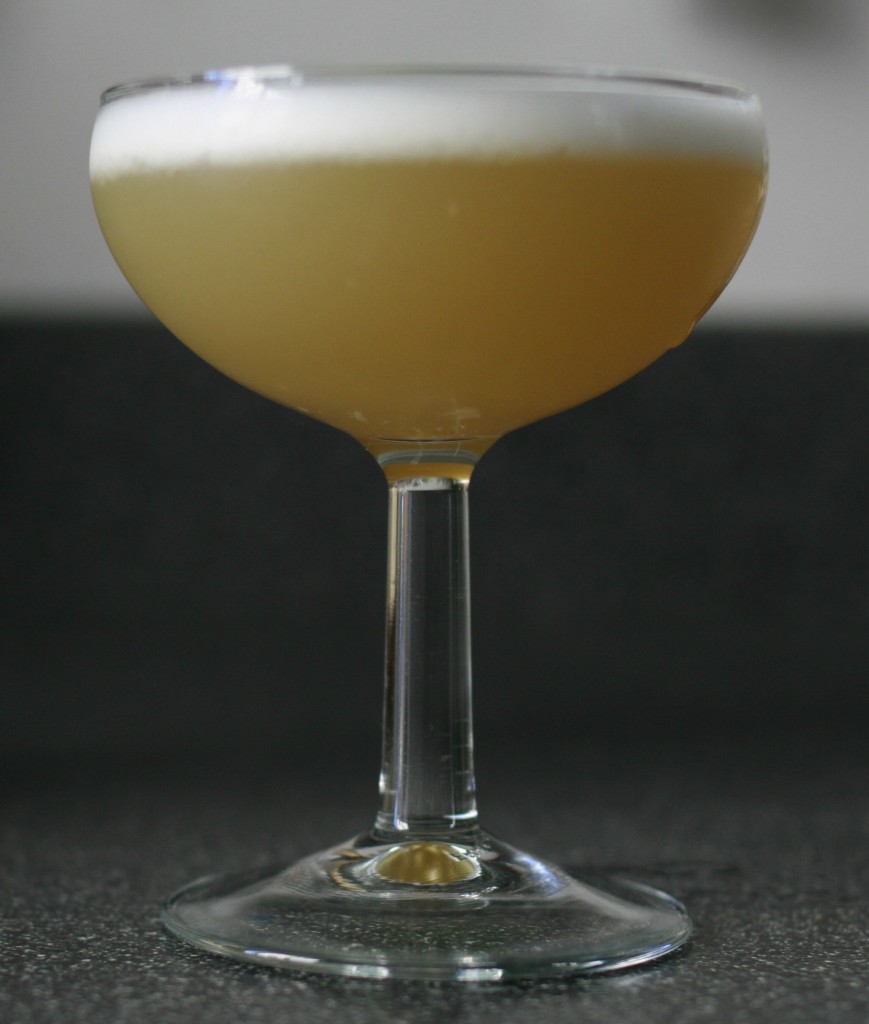Drink of the Week: The White Elephant (a la Wondrich)
 I sing now, for the umpteenth time, of the raw egg white, feared by many, adored by classic cocktail aficionados, and a sure way to get me to sit up and pay attention to almost any cocktail.
I sing now, for the umpteenth time, of the raw egg white, feared by many, adored by classic cocktail aficionados, and a sure way to get me to sit up and pay attention to almost any cocktail.
That’s a good thing, because this week’s drink could definitely use a little love. I stumbled over it at the massive bevatorium assembled by David Wondrich for Esquire and was immediately grabbed by the drink’s eggy simplicity. I was also struck by the immense terseness of the usually voluble Wondrich’s eight-word take: “A wet martini with a head; see the Hearst.”
What could a drink do to be both worthy of inclusion, yet apparently unworthy of sufficient verbiage — or even a reasonably accurate graphic? Was both Wondrich and the Esquire art department tired and on deadline? Was he forced to grudgingly submit to pressure to include this drink from the vast and shadowy gin-sweet vermouth-and-egg-white-industrial-complex?
Finally, why was every other cocktail I could find on line called “White Elephant” a completely different concoction that usually involved ingredients like coconut milk, white creme de cacao, heavy cream, white rum, and other things that are very, very white and nothing but white? This drink, as my brilliant photographic work reveals, is not precisely white, as elephants go. What gives? Who knows, but clearly the first thing to do is try the damn drink.
The White Elephant a la Wondrich
2 ounces gin
1 ounce sweet vermouth
1 egg white
1 cherry (garnish)
The drill is basically the same as for every cocktail involving egg whites or eggs. Combine the gin, vermouth, and egg white in a cocktail shaker, but with no ice. Shake well to emulsify the egg, then add ice and really shake well. Strain into a chilled cocktail glass or reasonable facsimile. Add a cherry for a bit of extra sweetness and color, and toast the pachyderm of your choice.
******
I have to say that while I thoroughly enjoy this drink and find it nicely refreshing yet neither too sweet nor too anything else, I can see what it maybe hasn’t taken off and has become, yes, a white elephant of a mixed drink. It’s not really sweet enough for the sweets lovers, nor is it boozy, complex, bitter, or tart enough for many a cocktail snob. It’s nevertheless got plenty of booze in it, and the combination of egg white, liquid, and ice guarantees it all goes down in the most delightful way. A wet martini not only with a head, but with a wonderfully comfy ova cushion.
I did try messing around a bit with ingredients and proportions. Lowering the amount of gin by half an ounce didn’t really hurt the drink, but the increase in sweetness turned out to be minimal. The results using both of my two fall back sweet vermouths, Noilly-Pratt and Carpano Antica, were just fine, though this time I leaned ever so slightly towards the lighter touch of Noilly-Pratt. Still, the only really wrong move I made was adding bitters. So often, bitters can really save a drink; sometimes, however, it’s just the reverse.
So, why is the White Elephant so benighted that even a chatty cocktail historian has almost nothing to say about it? I think it’s the name. Not only is it unflattering, it’s inaccurate. This elephant is not white. It’s another color entirely.
You can follow us on Twitter and Facebook for content updates. Also, sign up for our email list for weekly updates and check us out on Google+ as well.

 You’ve never heard of the today’s Drink of the Week for a very good reason. The Meyer-Canadian Semi Sour, as I’ve named it (any other suggestions?) is the first DOTW that is pretty much entirely my own variation on a
You’ve never heard of the today’s Drink of the Week for a very good reason. The Meyer-Canadian Semi Sour, as I’ve named it (any other suggestions?) is the first DOTW that is pretty much entirely my own variation on a  Sours are an entire family of cocktail which mostly utilize some combination of lemon juice and sugar. (The sour mix used by many bartenders is, in my experience, slightly revolting.). The Latin American favorite, the pisco sour, is probably a better known drink in many quarters these days, but the whiskey sour has been one of the
Sours are an entire family of cocktail which mostly utilize some combination of lemon juice and sugar. (The sour mix used by many bartenders is, in my experience, slightly revolting.). The Latin American favorite, the pisco sour, is probably a better known drink in many quarters these days, but the whiskey sour has been one of the 








